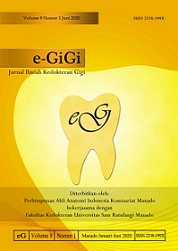Temporomandibular Joint Disorder in Malocclusion
Abstract
Abstract: Malocclusion is considered as one of the causative factors of temporomandibular joint disorder. However, there are still pros and cons to the role of occlusion as a pathophysiological factor for temporomandibular joint disorders (TMD). This study aimed to review the literature on the extent to which research had been carried out related to TMD in patients with malocclusion published from 2012 to January 2022. The method used in collecting data was guided by PRISMA-Scr through the Pubmed NCBI and Sciencedirect databases with relevant keywords. The obtained literature was screened and assessed for feasibility. Detail of data extracted with Microsoft Excel software. Based on the search, a total of 21 kinds of literature were suitable with the inclusion category as study material. The included literature consisted of cross-sectional studies (n=6), case-control (n=4), cohort (n=3), retrospective study (n=3), systematic review (n=2), systematic review and meta-analysis (n=1), and review study (n=2). Most of the literature said that there was no significant relationship between variations in occlusion irregularities and TMD associated with various signs and symptoms of TMD as well as variations in temporomandibular joint (TMJ) anatomy. TMD was actually more influenced by habits, personality, and psychological conditions. Treatments for TMD patients, either surgical or orthodontic, had a positive effect but were not significant. In conclusion, there is no relationship between temporomandibular joint disorders and malocclusion.
Keywords: temporomandibular joint disorder; malocclusion
Abstrak: Maloklusi dianggap menjadi salah satu faktor penyebab gangguan sendi temporomandibula. Hingga kini, masih terdapat pro dan kontra peran oklusi sebagai faktor patofisiologi gangguan sendi temporomandibular (temporomandibular joint, TMJ). Penelitian ini bertujuan untuk mengkaji literatur penelitian yang telah dilakukan berkaitan dengan gangguan sendi temporomandibula (temporoman-dibular joint disorder, TMD) pada maloklusi yang dipublikasikan pada 2012 hingga Januari 2022. Metode pengumpulan data berpedoman pada PRISMA-Scr melalui database Pubmed NCBI dan Sciencedirect dengan kata kunci yang relevan. Literatur yang didapat diseleksi dan dilihat kelayakan-nya. Detail data diekstraksi dengan software Microsoft Excel. Hasil pencarian mendapatkan sebanyak 21 literatur memenuhi kategori inklusi sebagai bahan kajian, terdiri dari jenis studi cross-sectional (n=6), kasus kontrol (n=4), kohort (n=3), studi retrospektif (n=3), tinjauan sistematis (n=2), systematic review dan meta-analysis (n=1), serta studi review (n=2). Sebagian besar literatur menyatakan bahwa tidak terdapat hubungan bermakna antara variasi tidak teraturnya oklusi terhadap TMD terkait dengan ragam tanda dan gejala TMD serta variasi anatomi TMJ (temporomandibular joint). Didapatkan TMD justru lebih dipengaruhi oleh kebiasaan, kepribadian, serta keadaan psikologis. Perawatan yang dilakukan pada penderita TMD, baik berupa bedah maupun perawatan ortodontik memiliki pengaruh yang cukup positif namun tidak bermakna. Simpulan penelitian ini ialah tidak terdapat hubungan bermakna antara gangguan sendi temporomandibula dengan maloklusi.
Kata kunci: gangguan sendi temporomandibular; maloklusi
Full Text:
PDFDOI: https://doi.org/10.35790/eg.v10i2.41754
Refbacks
- There are currently no refbacks.

